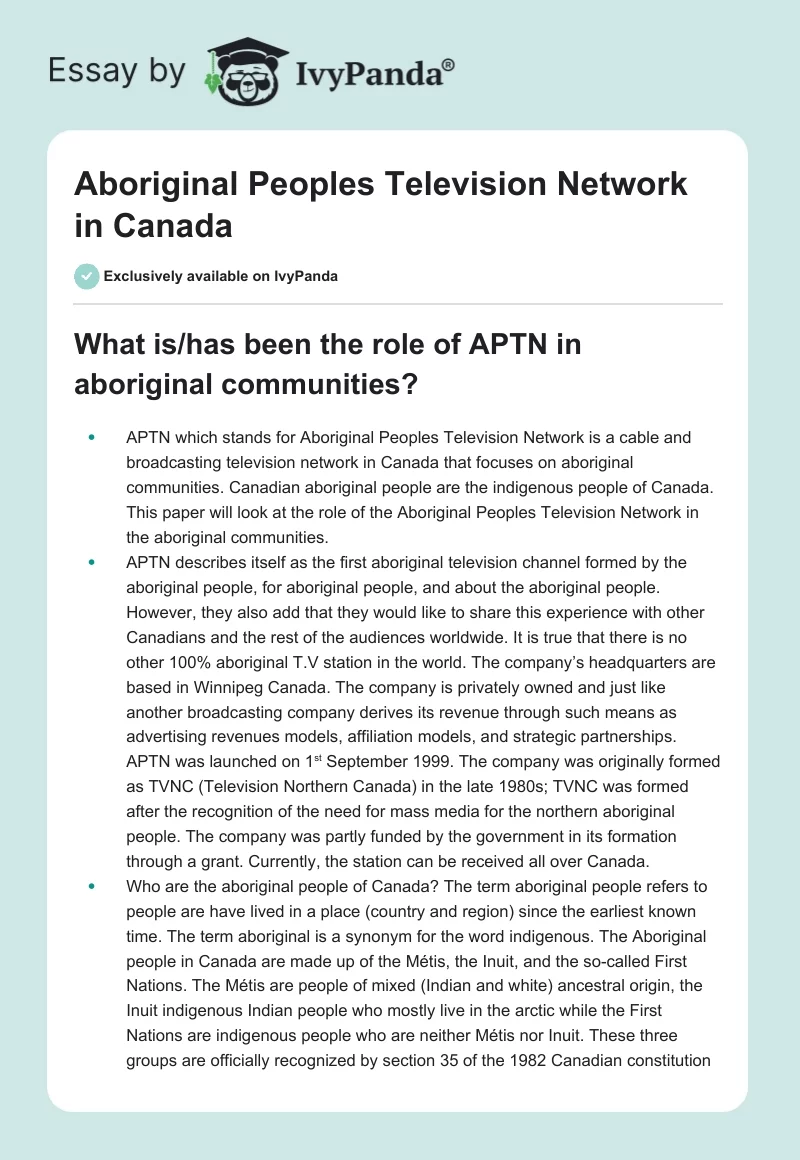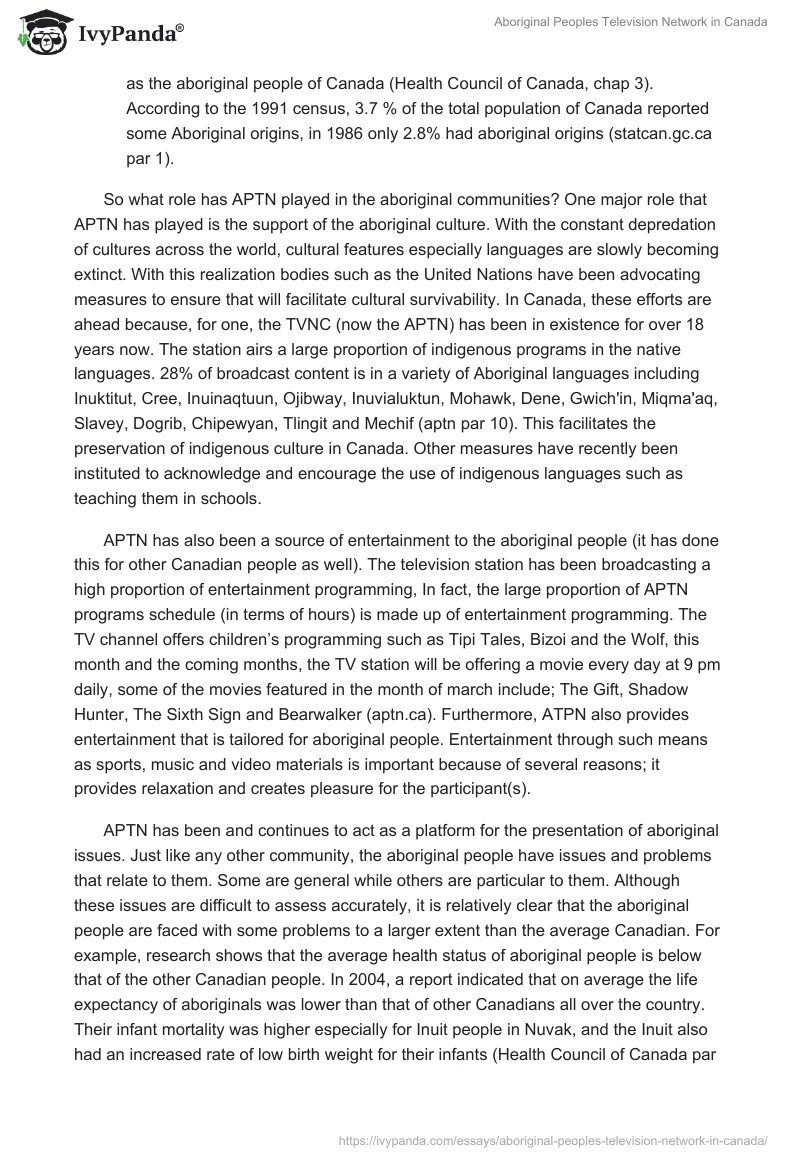What is/has been the role of APTN in aboriginal communities?
- APTN which stands for Aboriginal Peoples Television Network is a cable and broadcasting television network in Canada that focuses on aboriginal communities. Canadian aboriginal people are the indigenous people of Canada. This paper will look at the role of the Aboriginal Peoples Television Network in the aboriginal communities.
- APTN describes itself as the first aboriginal television channel formed by the aboriginal people, for aboriginal people, and about the aboriginal people. However, they also add that they would like to share this experience with other Canadians and the rest of the audiences worldwide. It is true that there is no other 100% aboriginal T.V station in the world. The company’s headquarters are based in Winnipeg Canada. The company is privately owned and just like another broadcasting company derives its revenue through such means as advertising revenues models, affiliation models, and strategic partnerships. APTN was launched on 1st September 1999. The company was originally formed as TVNC (Television Northern Canada) in the late 1980s; TVNC was formed after the recognition of the need for mass media for the northern aboriginal people. The company was partly funded by the government in its formation through a grant. Currently, the station can be received all over Canada.
- Who are the aboriginal people of Canada? The term aboriginal people refers to people are have lived in a place (country and region) since the earliest known time. The term aboriginal is a synonym for the word indigenous. The Aboriginal people in Canada are made up of the Métis, the Inuit, and the so-called First Nations. The Métis are people of mixed (Indian and white) ancestral origin, the Inuit indigenous Indian people who mostly live in the arctic while the First Nations are indigenous people who are neither Métis nor Inuit. These three groups are officially recognized by section 35 of the 1982 Canadian constitution as the aboriginal people of Canada (Health Council of Canada, chap 3). According to the 1991 census, 3.7 % of the total population of Canada reported some Aboriginal origins, in 1986 only 2.8% had aboriginal origins (statcan.gc.ca par 1).
So what role has APTN played in the aboriginal communities? One major role that APTN has played is the support of the aboriginal culture. With the constant depredation of cultures across the world, cultural features especially languages are slowly becoming extinct. With this realization bodies such as the United Nations have been advocating measures to ensure that will facilitate cultural survivability. In Canada, these efforts are ahead because, for one, the TVNC (now the APTN) has been in existence for over 18 years now. The station airs a large proportion of indigenous programs in the native languages. 28% of broadcast content is in a variety of Aboriginal languages including Inuktitut, Cree, Inuinaqtuun, Ojibway, Inuvialuktun, Mohawk, Dene, Gwich’in, Miqma’aq, Slavey, Dogrib, Chipewyan, Tlingit and Mechif (aptn par 10). This facilitates the preservation of indigenous culture in Canada. Other measures have recently been instituted to acknowledge and encourage the use of indigenous languages such as teaching them in schools.
APTN has also been a source of entertainment to the aboriginal people (it has done this for other Canadian people as well). The television station has been broadcasting a high proportion of entertainment programming, In fact, the large proportion of APTN programs schedule (in terms of hours) is made up of entertainment programming. The TV channel offers children’s programming such as Tipi Tales, Bizoi and the Wolf, this month and the coming months, the TV station will be offering a movie every day at 9 pm daily, some of the movies featured in the month of march include; The Gift, Shadow Hunter, The Sixth Sign and Bearwalker (aptn.ca). Furthermore, ATPN also provides entertainment that is tailored for aboriginal people. Entertainment through such means as sports, music and video materials is important because of several reasons; it provides relaxation and creates pleasure for the participant(s).
APTN has been and continues to act as a platform for the presentation of aboriginal issues. Just like any other community, the aboriginal people have issues and problems that relate to them. Some are general while others are particular to them. Although these issues are difficult to assess accurately, it is relatively clear that the aboriginal people are faced with some problems to a larger extent than the average Canadian. For example, research shows that the average health status of aboriginal people is below that of the other Canadian people. In 2004, a report indicated that on average the life expectancy of aboriginals was lower than that of other Canadians all over the country. Their infant mortality was higher especially for Inuit people in Nuvak, and the Inuit also had an increased rate of low birth weight for their infants (Health Council of Canada par 17). Statics also indicate that aboriginals have lower education levels, earn less, have higher arrest and imprisonment rates, and have higher unemployment levels. ATPN provides an avenue through which these issues can be brought to the limelight. Through their in-depth and persistent coverage of these issues in their news, programs, and discussions on the web, they can get the attention of authorities and the general Canadian public. Other media organizations also cover such issues; however, since they are not specialized in aboriginal people the quantity of their reports is lower than that of ATPN.
The television station has also been and continues to be a source of news and education to the aboriginal communities. For example, there are educational programs offered such as the Geographic, a documentary program that focuses on Canadian wildlife. ATPN is a source of national news and news that focuses on the aboriginal communities.
APTN acts as a link between the Aboriginal people, the other Canadian people as well as the global community. People outside the aboriginal community usually have a generalized view of the aboriginal people; they will apply a cover that represents the culture and lifestyle of an aboriginal person. However, there are wide variations between the various aboriginal people as well as within one type of aboriginal group. These variations arise in areas of culture, problem areas, political inclinations, and lifestyle. APTN has been providing an insight into the different aboriginal groups through their programming.
The station has also been providing a platform for aboriginal people. Firstly, since its formation, the company has been a source of employment for many aboriginal producers, reporters, editors, and news anchors. More than three-quarters of the current 300 member staff are aboriginal and last year (2009), APTN was named as a Manitoba Top Employer (aptn par 1). By providing a medium through which the aboriginal content such as music, TV programs and art can be relayed to the masses the APTN achieves several purposes; it gives these people exposure to the external world and thus creating a market for them and It also helps create aboriginal personalities who can latter move into worldwide arenas such as Hollywood. The station also presents content from other aboriginal communities from various parts of the world such as New Zealand, Australia, The United States and South America. The company also sponsors aboriginal related activities and occasions. For example this year it is teaming up with The Regina Leader-Post and the Saskatoon StarPhoenix together with other partners to sponsor the National Aboriginal Achievement Awards.
Conclusion
The aboriginal people in Canada consist of the Métis, the Intuits and the First Nations. APTN (Aboriginal People Television Network) is a national television station that focuses on aboriginal issues. The company was initially formed as TVNC (Television Northern Canada) in 1992 before being renamed APTN in 1999. In its history and even now, APTN has played a number of roles for the Canadian aboriginal communities. It has provided a bigger avenue through which aboriginal issues can be expressed. It has been a source of news and education particularly for aboriginal people. Thirdly, it has been providing entertainment services to aboriginal people. The station has also been linking the aboriginal (Canadian aborigines and other aborigines) people with the other non-aboriginal people in Canada and over the world. Finally the station provides a platform for aboriginal talent and skills to be exposed to the market.
Works Cited
aptn. “aptn movies”. n.d. 28.03. 2010. Web.
aptn. “Milestones; key events in APTN’s history from 2009 back to 1978.” n.d. Web.
Global Television, APTN and Regina Leader-Post and Saskatoon StarPhoenix major media partners for the 2010 National Aboriginal Achievement Awards’ ” n.d. Web.
Health Council of Canada. “The health status of Canada’s first nations, Métis and Inuit people” 2005. Web.
Statcan. 2001 Census Consultation Guide: Aboriginal Peoples Recent Trends. Web.


